
Embark on a comprehensive exploration of Oceanography with UPSC Geography Optional Mains Topic Wise Questions. Dive into the depths of marine science, unraveling the mysteries of the world’s oceans essential for UPSC mains preparation. Each question is meticulously designed to enhance understanding and analytical thinking, covering a diverse array of oceanographic phenomena and processes. From ocean currents to marine ecosystems, aspirants gain profound insights into the dynamic interplay shaping Earth’s aquatic realms. With detailed explanations and structured content, this resource serves as an indispensable tool for mastering oceanographic principles, crucial for success in the UPSC examination. Whether you’re a seasoned aspirant or new to the subject, immerse yourself in the study of Oceanography to excel in your UPSC Geography Optional Mains journey.
Contents
- 1 Q1. Give a reasoned account of the distribution of salinity in the oceans and partially enclosed seas. (1993)
- 2 Q2. Discuss the different bases for classifying the ocean deposits and give a detailed account of pelagic deposits of the oceans. (2007)
- 3 Q3. Ocean currents of Northern Atlantic Ocean. (2006)
- 4 Q4. Present a concise account of bottom relief of the Indian Ocean. (2003)
- 5 Q5. Explain and illustrate the submarine relief of the Atlantic Ocean. (1998)
- 6 Q6. Marine resources-biotic, mineral and energy resources. (1997)
- 7 Q7. Explain and illustrate the ocean floor topography and give a detailed account of the Mid-Atlantic Ridge. (1996)
- 8 In case you still have your doubts, contact us on 9811333901.
Q1. Give a reasoned account of the distribution of salinity in the oceans and partially enclosed seas. (1993)
Answer:
Salinity refers to the total quantity (or concentration) of dissolved inorganic solids in water. It is defined as total amount of solid material in grams contained in one kilogram of sea water and is expressed as part per thousand (1‰).
The oceanic salinity not only affects the marine organisms and plant community but it also affects the physical properties of ocean water like temperature, density, currents etc. More saline water freezes slowly while less saline water gets evaporated more. Salinity introduces electrical conductivity in ocean water and makes possible the process of reverse osmosis, a source of energy. Salinity is also one of the factors controlling oceanic currents.
Salts, most probably came along with oceans, when oceans and atmosphere were formed through the complex process of degassing. Many agents such as running water, winds, waves, etc., have been carrying dissolved materials from the land to the oceans. Sodium chloride is the most abundant salt in the oceans followed by Magnesium chloride, Magnesium sulphate and calcium sulphate.
Controlling Factors: Salinity is influenced by two sets of factors
(i) Addition or extraction of water which is done by precipitation, melting of glaciers etc. and evaporation respectively. Addition reduces salinity while extraction increases it.
(ii) Mixing in ocean water generally lowers salinity.
Distribution: The average salinity in ocean and seas is 35% but there is spatial variation in the amount of salinity. Salinity distribution is primarily affected by latitudes. There are four distinct latitudinal zones having different salinity:
(i) The Equatorial Zone: The salinity is slightly below the normal here due to exclusive precipitation and comparatively lesser evaporation because of high relative humidity and calm conditions in the doldrums.
(ii) The Tropical Zone (20°-40°): Salinity reaches maximum in this zone since there is lower precipitation, higher evaporation due to higher temperature, faster winds and arid and semi-arid conditions (deserts) prevailing here.
(iii) The Temperate Zone (40°-60° Latitudes): Plenty of rainfall and low temperatures reduces the salinity in this zone.
(iv) The Polar-Zone of Low Salinity (60°-90°): Salinity is low since the region records the lowest temperatures and very low rate of evaporation.
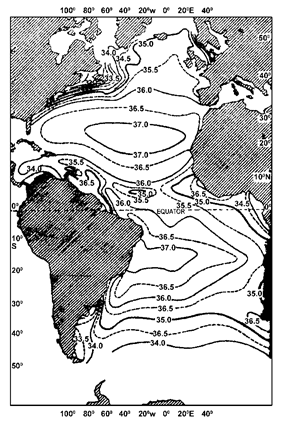
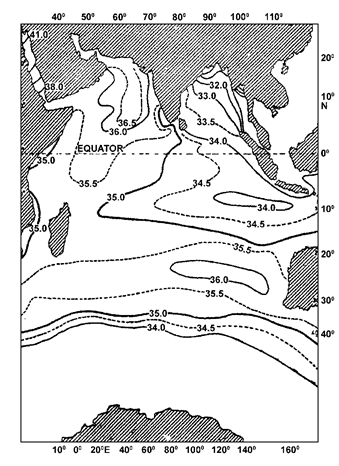
Regional-Pattern: Atlantic ocean
The Atlantic has an average salinity of 36%. In higher latitudes, the more saline water is brought by the North Atlantic Drift to the eastern part of North Atlantic. On the western coast at similar latitudes the cold Labrador Current lowers the salinity. On the western coast of Africa, salinity is lower due to upwelling of cold water and addition of freshwater from Congo and Niger rivers.
In South Atlantic isohalines are generally parallel to the latitudes due to greater expanse of water. Along the Brazilian coast, more salinity is found due to warm Brazilian Current. At the river mouths low salinity is observed: St. Lawrence-31%, Amazon-15%, Congo-34%, Niger-20% etc.
Partially Enclosed Seas: Some other factors have greater influence here. North Sea despite located in higher latitudes records higher salinity (34‰) due to influx of warm North Atlantic Drift whereas Baltic Sea records low salinity because of river water influx and precipitation. Salinity becomes as low as 2% in Gulf of Boshnia due to influx of freshwater.
The Mediterranean Sea records high salinity due to high evaporation and little mixture of Atlantic water. In this sea, the salinity increases as we move from Gibralter (36%) to the east (39%) since there is more temperature and high rainfall in the eastern part. There is high salinity in the Gulf of Mexico (36‰) and the Caribbean Sea due to more saline water brought by the north equatorial current.
Indian Ocean: In the North Indian Ocean, isohalines run almost across the ocean, because of the effect of monsoonal circulation and the 35% isohaline practically divides the North Indian Ocean into eastern and western sections. In the eastern section, salinity is low due to higher precipitation and the large no of rivers draining fresh water into it. In the Arabian sea, high temperature, aridity and lesser influx of river water increases the salinity to over 36%.
In the South Indian Ocean, isohalines run more parallel to the latitudes than in the Atlantic. The maximum salinity in the southern part is found along the western coast of Australia due to dry conditions.
In the partially enclosed seas of Indian Ocean, high salinity is found in the Red Sea (37-41% highest) and Persian Gulf (37-40%) due to very high evaporation, lesser rainfall and relative absence of rivers.
Pacific Ocean: In the Pacific Ocean salinity varies in the range of 34 to 35% in the equatorial zone while in the tropical zone it increases to 35.5% to 36%. Between 15°-30° latitudes an elliptical area of 35.5% salinity is found in Northern Pacific but it becomes still higher (36%) in Southern Pacific between the same latitudes. In North Pacific along the western margin of the ocean salinity is lowered to 31‰ in Okhotsk due to influx of cold water of Oyashio current as a result of ice melt and weakening of warm Kuroshio current.
An elongated projection of low salinity of about 35‰ is found in California and Peruvian Coast due to upwelling of cold water. River mouths like Huang Ho and Yangtzekiang record lower salinity of about 30 to 33‰ respectively.
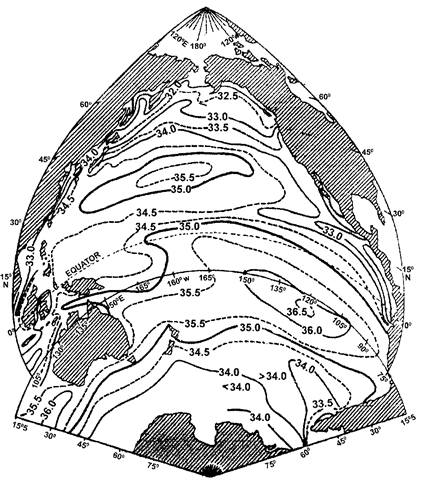
Q2. Discuss the different bases for classifying the ocean deposits and give a detailed account of pelagic deposits of the oceans. (2007)
Answer:
The oceanic sub-system of earth is more diverse and complex than land sub-system. The occurrence and availability of deposits over ocean floor proves this beyond doubt. All the materials that accumulate on the ocean floor is known as Ocean deposits. The first method to classify the oceanic deposits on the basis of their origin was proposed by Sir John Murray and A.F. Renard in 1891. This classification proved to be very useful in understanding about oceanic deposits.
On the basis of aforementioned classification, the oceanic deposits may be classified as:
- Terrigenous Deposits: These are sediments derived from the land and transported to the ocean by flowing water, wind, glacier and sea-waves. About 16.5 billion tonnes of terrigenous sediments are transported to sea by rivers and winds every year. The colour of these sediments is often red or brown.
- Biogenous Sediments: These deposits are of biological origin. They consist mainly of materials of marine origin organic materials like shells and skeletons of marine animals and plants. They cover about half of the deep ocean bottom. They are abundant near regions of greater biological activity.
- Hydrogenous Sediments: These have been precipitated directly from sea-water. One principal example is manganese nodule which is a complex mixture of minerals which forms very slowly on the ocean floors.
- Cosmogenous Sediments: These are of extra-terrestrial origin which result generally from impacts of meteorites. They are of isolated occurrence.
On the basis of size of particles ocean deposits can be as follows; boulder, whose diameter is more than 256mm, cobble, pebble, granule,sand, silt and clay. On the basis of place of their occurrence, the oceanic deposits are the deposits of continental shelves, continental slopes, continental rise and deposits of deep-ocean floors. As far as the pelagic deposits are concerned, these are most conspicuous on the deep sea plains and in the deep covering about 75 per cent of the oceanic area. Wherever the supply of terrigenous mud is not much on the slopes, the deposits become more or less pelagic in type.
The pelagic deposits are both organic and inorganic in nature. They consist partly of the remains of marine animals and plants and partly of the volcanic dust brought by the wind. Pelagic deposits consist of matter derived from algae and are mostly in the form of liquid mud, generally known as ooze. The pelagic materials are divided into two groups:
- Calcareous Oozes: It contains lime context in abundance and are seldom found at greater depths because of their high degree of solubility. They are generally found at the sea floor between 1000 fathoms to 2000 fathoms. Calcareous oozes are further sub divided into two types:
- Pteropod Ooze: Pteropod oozes are formed of floating pteropod molluscs. It contains 80% calcium carbonate and is mostly found in the tropical oceans and seas at the depth of 300-1000 fathoms. It practically disappears beyond 2000 fathom depth. The main location includes the western and eastern parts of Pacific Ocean, Mid-mediaterranean submarine ridge and Indian Ocean.
- Globigerina Ooze: It is made up of shells of various foraminifera, especially globigerina. Besides milky white colour, it is also blue, grey, yellow and green in colour. Globigerina is generally found between the depths of 2000 to 4000 fathoms. It is found mostly in the tropical and temperate zones of the Atlantic, on the eastern and western continental shelves of the Indian Ocean and in the eastern Pacific Ocean.
- Siliceous Ooze: The ooze becomes siliceous in nature when silica content dominates. Silica in derived from a group of protozoa or radiolarians and benthic animals mainly sponges. Because of less calcium carbonate and dominance of silica, siliceous ooze is not as soluble as calcareous. Hence such oozes are found in both warm and cold water at greater depths. There are two sub-types of these oozes.
- Radiolarian Ooze: It is formed by the shells of radiolaria and foraminifera. The amount of calcium carbonate is insignificant, averaging 4%. This ooze is found in the tropical oceans and seas up to a depth of 2000 to 5000 fathoms. It covers the largest areas in the Pacific Ocean.
- Diatom Ooze: It is made up of plant shells very microscopic in size containing silica in abundance. It is significantly found in the zone around Antarctica and a belt from Alaska to Japan in the North Pacific at the depth fo 600-2000 fathoms.
Red Clay: In addition to oozes, there is red clay which is made up of extremely fine material and is apparently of volcanic origin. These are found on deep sea basins. It covers 38% of total oceanic area. It is the most important inorganic matter and most widely spread pelagic deposit. It consist mainly of hydrated silicate of alluminium (85.35%) and oxides of iron. It also contains decomposed volcanic material. It may be noted that red clay contains more radioactive substances than any other marine deposit. It is soft, plastic and greasy in character Red Clay is widely distributed at the great depth in all the oceans. It dominates in the zone between 40°S in the Atlantic, eastern part of the Indian Oceanand the North Pacific Ocean covering 129 million km square of area.
Q3. Ocean currents of Northern Atlantic Ocean. (2006)
Answer:
Ocean currents of Northern Atlantic are as follows:
A. North Atlantic Ocean Warm Currents
- North Equatorial Current : Normally, the north equatorial current is formed between the equator and 10°N latitude. This current is generated because of upwelling of cold water near the west coast of Africa. On the average the north equatorial warm current flows from east to west. This current, after being obstructed by the land barrier of the east coast of Brazil is bifurcated into two branches. The Antilles current is diverted northward and flows to the east of West Indies Islands and helps in the formation of Sargasso Sea and the second branch known as the Caribbean current enters the Gulf of Mexico.
- Counter-Equatorial Current: Counter equatorial current flows from west to eastbetween the westward flowing strong north equatorial currents. This current is less developed in the west due to stress of trade winds. The counter current mixes with the equatorial currents in the west but it is more developed in the east where it is known as the Guinea Stream. The counter equatorial current carries higher temperature and low density because of the influence of equatorial westerlies which blow from west to east in the calm zone of the doldrums.
- Gulf Stream: The Gulf Stream is a system of several moving currents in north-easterly direction. This current system originates in the Gulf of Mexico around 20°N latitude and movesin north-easterly direction along the eastern coast ofNorth America and reaches the western coasts of Europe near 70°N latitude. This system’s name is Gulf Stream because of its origin in Mexican Gulf and consists of (I) Florida current from the strait of Florida to Cape Hatteras, (II) Gulf Stream from Cape Hatteras to theGrand Bank and (III) North Atlantic Drift from Grand Bank to the Western European Coast.
The Gulf Stream loses its original characteristic near 40°N latitude because it mixes with the cold Labrador current. Gulf Stream and Cold Labrador current near New foundland results in the formation of dense fog which causes obstruction in the navigation of ships.
The Gulf Stream is divided into many branches at 45°N latitude and 45°W longitude. All the branches are collectively called as North Atlantic Drift. It undergoesmajor changes because of mixing of cool water of the Labrador current with its warm water. This current dividedinto several minor branches.
- One branch flows along the coast of Norway acrossWyville Thompson Ridge and reaches the Norwegian Sea
- Second branch is known as Irminger current which flows north and north-westward upto the southern coast of Iceland.
- Third branch moves towards the eastern coast of Greenland where it joins the Greenland current. The Eastern Branch is warmer than the northern branch. This branch flows in easterly direction and reaches the western coasts of France and Spain.
This branch can be divided into several sub-branches: (a) one branchenters the Mediterranean Sea, (b) Rennell current channel enters the Bay of Biscay to flow up France and Spain and (c) the third branch is the main branch which flows through the coasts of Spain, Azores etc. and reaches the western coast of Africa to join the old Canary current.
Gulf Stream is responsible for unique characteristic of West European type of climate.
(B) North Atlantic Cold Current
- Canary Current: Cold current flowing along the western coast of North Africa between Madeira and Cape Varde. This current is the continuation of North Atlantic Drift which turns southward near the Spanish coast and flows to the south along the coast of Canaries island. The Canary cold current influences weather conditions of the western coast of North Africa.
- Labrador Current: Originates in the Baffin Bay and Davis Strait and after flowing through the coastal waters of Newfound- land and Grand Bank it merges with the Gulf Stream. This current brings within a large number of big icebergs as far South as Newfoundland and Grand Bank. Dense fogs are also produced due to the convergence of the Labrador cold current and the Gulf Stream near Newfoundland.
Q4. Present a concise account of bottom relief of the Indian Ocean. (2003)
Answer:
It is in the recent past that ocean have become an important focus of study. The study of the bottom relief of the ocean bodies have thrown considerable light in understanding the major geological processes and phenomena which helped in the evolution of the revolutionary theory of Plate Tectonics.
The surface beneath the water is characterised by a great diversity of relief features and the Indian Ocean is no exception to it. Indian Ocean is the third largest ocean after the Pacific and the Atlantic. It is a warm ocean bounded on all the sides by the continents of Africa, Asia, Australia and Antarctica. Its shores consist of some of the ancient plateaus (Africa, Arabia, the Deccan and the Western Australia) and the remains of the Gondwanaland. The shape of the ocean is compact with bold and regular coastlines.
The Indian Ocean did not exist before Cretacious period, as per the theory of Plate Tectonics. Chronological sequence of the evolution of Indian Ocean is done on the basis of magnetic anomalies according to which Indian Ocean began to be formed after the breaking up of Panagaea, when Indian Plate began to move northward during early tertiary period. During same time, Antarctica broke away from Australia. Thus, the Pacific Ocean began to shrink in size becaue of expansion of the Atlantic and Indian Ocean, a process which is continuing even today.
Indian sub-continent in the north divides the Indian Ocean into Arabian sea and Bay of Bengal. The Ocean widens in the south. Johnson has divided the Indian Ocean in three zones:
- The Western Zone between African coast and the mid Indian Oceanic Ridge has large number of islands with average depth of 365 metres.
- The Eastern zone is deepest with average depth of 550 metres.
- The Central zone represents the mid-oceanic ridge where many tiny islands are located.
The bottom relief of the Indian Ocean, as depicted in the given figure, reveal following salient features:
Continental Shelf: Indian Ocean is also characterised by the continental shelves of varying width. Wider shelf is found in the Bay of Bengal and the Arabian Sea, attaining the maximum width of 400 miles. Extensive shelves are found along the eastern coast of Africa and around Madagascar, which itself is located on the continental shelf. In general, the continental shelves are very wide in the west, while these are narrow in the east along the coast of Java and Sumatra. The shelf becomes further narrow along the Antractica continent.
Mid Oceanic Ridge: Mid-oceanic ridge system is also present in the Indian Ocean, representing the diverging boundary of the movement of the Austral-Indian Plate and the African plate. These are characterised by the basaltic lava eruptions and shallow-foci earthquakes.
The Mid-Indian Oceanic Ridge is wider and less prominent than the Atlantic ridge. However, it extends the whole length of the Indian Ocean, almost in north-south direction and forms a continuous chain of highlands. The ridge starts in continuation of the contenental shelf of the southern tip of Indian Peninsula. Here, it is known as Laccadive-Chagoes ridge. The ridge extends further south and widens near equator. Between 0° and 30°S it is called Chagas-St. Paul ridge or Mid-Indian rise. Further south, the Indian ridge widens 1000 miles in the form of Amsterdam-St. Paul plateau, extending between 30°-50°S and 65°-110° E. The ridge bifurcates from 50°S latitudes, the western branch is known as Kerguelen-Gaussberg ridge extending in NW-SE direction and eastern branch is known as Indian-Antarctic ridge.
Branches of the central ridge:
- Socotra-Chagos ridge, also known as Carlesberg Ridge emerges from the central ridge at 5°S and extends in north-westerly direction, dividing the Arabian Sea almost into two parts.
- Seychelles- Mauritius ridge bifurcates from the main ridge around 18°S near Mauritius Island and extends in N-W direction to Seychelles and Amirantes Island.
- Madagascar ridge stretching from Madagascar to 40°S latitude.
- South-Western Indian Ridge, a S-W branch near 23°S latitude.
- Andaman-Nicobar ridge extends from the mouth of Irrawaddy to Nicobar Islands.
Ocean Basin : The Central Ridge and its various branches divide the Indian Ocean into many basins. Chief among them are:
- Oman Basin
- Arabian Basin
- Somali Basin
- Mauritius Basin
- Mascarene Basin
- Agulhas Natal Basin
- Atlantic-Indian-Antarctic Basin
- Eastern Indian-Antartic Basin
- Andaman Basin
- Cocos or Keeling Basin
Deeps and Trenches: The floor of the Indian Ocean has fewer irregularities in comparison to the other two oceans. About 60 per cent of the total area forms the deep-sea plains, with a depth between 3600 metres and 5500 metres. Linear deeps are almost absent. Significant trenches are Java or Sunda Trench (7450m), Ob Trench (6875 m), Mauritius Trench, Amirante Trench, etc.
Islands: The Islands in the Indian Ocean are of great variety, such as:
- Large Islands like Madagascar and Ceylone.
- The small ones as Socotra, Zanzibar and Comoro.
- The Andaman and Nicobar islands as part of the submerged folded mountains.
- Laccadives and Maldives are located on the submerine ridge having coral formation.
- Mauritius and Re-union Islands as volcanic cones.
The eastern part of the Indian Ocean is almost devoid of islands, for the ocean floor is uniformly deep. The tiny Cocos group and Christmas Island are the only exception.
Marginal Seas: The Indian Ocean has very few marginal seas, partly due to the surrounding plateau coasts. The Arabian Sea and the Bay of Bengal are merely northward prolongations of the ovean proper.The Andaman Sea is the basin enclosed between the Andaman Nicobar arc and Kra Ithumus.
The Red Sea and the Persian Gulf are located on the continental shelves. Red Sea is an example of axial trough, a continuation of the rift valley system of East Africa which are believed to have formed along a zone of “incipient divergent plate boundry”. It completely reparates Arabian Peninsula from Africa. The Red Sea and the Gulf of Aden are located at the junction of three plates viz. Nubian plate, Somali plate and Arabian Plate. The Red Sea is reparated from the Indian Ocean by the submerged rock still across the strait of Bab-al-Mandeb. The Persian Gulf is a shallow trough which is being slowly filled with the sediments of Tigris-Euphrates. The region around it is known for its vast oil reserves.
Q5. Explain and illustrate the submarine relief of the Atlantic Ocean. (1998)
Answer:
The Atlantic Ocean located between North and South Americas in the West and Europe and Africa in the east, is the most widely studied ocean. It covers an area of 82 million square kilometer, which is about 1/6 th of the total area of the world. The shape of the ocean is very striking in the form of letter ”S” which Indicates, according to the theory of Plate Tectonics, that the contenents on either side of the ocean where once united, forming a part of the single landmass known as Pangea. Thus the study of bottom relief of the Atlantic ocean has considerably helped in the evolution of the revolutionary theory of Plate Tectonics.
The Atlantic Ocean was formed due to drifting of North and South Americas to the west during Mesozoic period. The ocean widens to the south of equator and narrows down towards the equator. Out of the total area of the Atlantic basin. 25.7% area is less than 2000 metre in depth, due to the sallowness of many enclosed and marginal seas and the extensive width of the continental shelf. The bottom features of the Atlantic Ocean reveal four salient features as shown in the given figure.
1.Continental Shelf: Continental shelves have developed along both the coasts of the Atlantic ocean and the width ranges from 4km to more than 80 km. In fact the width of the shelf varies according to the nature of the coast wherever mountains approach the shores the shelf is narrower, as off the coasts of Africa from the bay of Biscay to the cape of Goodhope, and of the coast of Brazil between 5o and 100 south latitude. The width here is between 50-100 miles only along the northern shore of European continent, and along Labrador, wide shelf is found ranging between 150-250 miles. Between Florida and New Found land it is wider than the average width around New Foundland Grand Bank and British Islands (Dogger Banks), worlds widest continental shelves are found, Around Green land and Iceland also wide continental shelves are observed. In the south Atlantic the shelf widens south of Bahia blance.
Many marginal seas are located on the continental shelves in the North Atlantic but such seas are practically absent in the South Atlantic. The significant seas are the Hudson bay, the Baltic seas, the North Sea, the Davis Strait etc. The carribbean Sea and Mediterranean Seas represent enclosed Seas. There are several Islands such as British Isles Iceland, faeroes, Azores, Madeira, Canaries, Cape Verde etc., in the North Atlantic continental shelf area and Ascension, Tristan da Cuncha, St. Helena, Falkland, Georgia, Sandwitch etc in the South Atlantic continental shelf areas.
2.Mid Atlantic Ridge: This is the most striking bottom relief feature of the Atlantic Ocean, representing the zone of Divergent or constructive plate boundary. Having the shape of S it extands for 14,450 km. from Iceland to Bouvet Island in the south. The mid- Atlantic ridge is a zone of volcanism where basaltic magma errupts and solidify.
The ridge is known as Dolphin Rise to the north and Challanger Rise to the south of equator. The ridge becomes quite extensive to the south of Greenland and Iceland, called Telegraphic Plateau. Other branches of this ridge include New Foundland Ridge, Azores Ridge, Para Ridge etc.
3.Ocean Basins: The important basins between the two major basins of East & West Atlantic are shown in figures given below.
Fig (i) Cross section of the North Atlantic ocean. 1. Puerto rico basin, 2. North American basin, 3. North Atlantic ridge, 4. Cape vere basin and 5. West African coast.
Fig (ii) Cross section of the South Atlantic Ocean 1. East South American coast, 2. Argentina basin, 3. South Atlantic ridge, 4. Walves ridge, 5. Cape basin and 6. Cape town.
- Labrador Basin: Located between Greenland in the North and New Foundland rise in the south having depth of basin between 4000-4500 metre.
- North American Basin : The extensive basin of the Atlantic Ocean having depth of more than 5000 metre.
- Brazilian Basin: Confined between equator and 30° south latitude with a depth of more than 4000 metre.
- Spanish Basin: Located between mid Atlantic ridge and Iberian peninsula has the average depth of 5000 metre.
- North and South Canary Basin: These are 5000 metre deep.
- Cape Verde Basin: located between mid Atlantic ridge and west African coast, average depth is 5000 metre.
- Guinea Basin: Between Guinea ridge and Sierra Leone Rise. The depth ranges between 4000 to 5000 metre.
- Angola Basin: Located between equator and 30° south latitude the average depth is 5000 metre.
Other significant basins are Cape Basin (25° south to 45°south), Aglhas Basin (40°-50° south), Argentina Basin (35°-50° south) and Atlantic-Antarctic Basin.
4.Ocean Deeps: There are less number of deeps in the Atlantic ocean than in the Pacific ocean, because of the absence of the effects of Tertiary organic movements along the Atlantic coasts.
The Important deeps of the Atlantic Ocean are given below.
- Nares deep-6000 m. deep
- Puerto Rico Deep – 8385 metre
- Hatteras Deep-5445 metre
- Columia Deep-5125 metre
- Valdivea Deep-3134 metre
- Romanche Deep-9370 metre
- Buchanan Deep-3063 metre
- Moseley Deep-3309 metre
- Vema Deep-4900 metre
Marginal Seas: The details of the marginal seas are :
Mediterranean: It is a deep elongated basin found to be extending from east to west. A ridge less than 2000 metre deep extending from south Italy to the African coast divides it into western and eastern parts. The western part is again subdivided into the Alguers- Provencal Basin in the west and the Tyrrhessian basin in the east.
The continental shelf is broad (80-240 k.m.) along Spanish (eastern), Italian (western), Greek (western), Egyptian (northern), Tunisian and Lybian (north-eastern) coasts.
Caribbean Sea and Gulf of Mexica: This enclosed portion of the Atlantic bordered by North and South Americas is separated by a 1600 meter deep ridge running between Yucatan peninsula and Cuba island. The prominent basins are Mexico basin and Caribbean basin.
Q6. Marine resources-biotic, mineral and energy resources. (1997)
Answer:
The wealth of sea is large. The sea is the store house of various important resources – biotic, mineral and energy resources. All the resources are not being utilised since we have limited expertise to utilise them on a cost-effective basis.
- The biotic resources contained in the sea are gigantic in proportion. Of these humans consume numerous varieties of fish, crustaceans, sea weeds, molluscs and other edible forms of marine life. Fish is the most important biotic resource from the point of view of human consumption. Fish provides necessary protein in the diets of millions of people the world over. Fishing as an economic activity is of tremendous importance to the countries like China, Japan, Norway, Peru, Holland, Scotland etc.
- Other biological products include oil, fur, leather, glue and cattle-feed from marine organisms. Leather is obtained from the hides of sea animals like whales, pearls, corals, oyester, clams, shrimps, sponges etc. Hydrogenated whale oil is used in margarine and in the manufacture of glycerine, soaps, varnishes, glue etc. Marine plants and animals are used in curative medicines. Iodine and potash are obtained from sea weeds. Seaweeds are also used in cooking and textiles. A notable aspect of these resources is that they are easily available and nearly inexhaustible.
- The mineral resources found in the oceans include both metallic and non-metallic minerals. The list is very long including petroleum, natural gas, monozite, manganese, sulphur, phosphorite, titanium, iron, gold, tin, platinum, sand etc. and the polymetallic nodules of copper, zinc, nickel, manganese and cobalt. Oil and natural gas are the most important of all these resources. However, sea mining is many times costlier than land mining for any mineral.
- Energy from the oceans can be harnessed in many ways-from tidal waves, through ocean thermal energy conversion (OTEC) and geothermal energy.
- A lot of energy is released by tides when they strike against the shore. A turbine can be operated to produce electricity by using the piston action of tides. Some countries like USA, Japan, France etc. are already producing power from tides. India also has good potential of tidal power especially in the Gulf of Cambay. Likewise, the difference between surface and subsurface temperature in tropical oceans can be used to generate electricity. Moreover, the heat from fracture zones and volcanoes under sea also has immense potential for power generation. Countries like USA, Mexico, New Zealand etc. are already generating power in this way.
Q7. Explain and illustrate the ocean floor topography and give a detailed account of the Mid-Atlantic Ridge. (1996)
Answer:
The study of the ocean floor topography has thrown valuable light in understanding the various geological processes and past geological events that have led to the formation of earth’s crust and other associated features.
The surface beneath the ocean water is characterised by a great diversity of relief features, i.e. towering mountain chains, deep canyons, flat plains, trenches etc. Ocean floor topography has been classified following categories:
(1)Continental Shelves: The shallow submerged extension of continent is called continental shelf. The depth of sea water here is 200 metres or 100 fathoms (one fathom = 6 feet). The mean slope of shelf is less than one degree while the average width is about 70 km, though the width varies greatly at different locations. The widest shelf, 1280 km across, lies north of Siberia in the tectonically quiet Arctic sea. The shelves occupy about 7.6% of the ocean floor. They have become increasingly important because of exploration of natural resources.
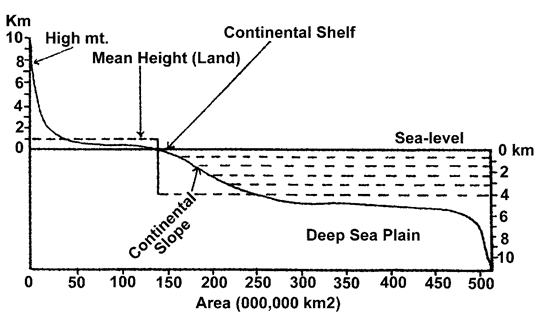
(2)Continental Slope: Seaward of the continental shelf continuously sloping portion with a steeper gradient of 2 to 5 degrees is known as continental slope. They average about 20 km wide and end, usually at a depth of 3700 metres. They occupy only about 8.5% of the total area of ocean floor but it varies in different oceans. The site of the slope also indicates the end of the continental block.
(3)Deep-Sea Plains: Deep-sea plain characterised by flat and rolling submarine plain is the most extensive relief zone of ocean floor topography. Having depth from 3000m to 6000m, they cover 75.9 % of the total area of ocean basins.
(4)Submarine Trenches & Island Areas: A trench is a long, narrow & steep sided depression on ocean bottom, usually 5,500 metres in depth. Curving chains of volcanic islands & sea mounts are almost always found paralleling concave edges of trenches. Trenches & island arcs formed by tectonic activity associated with plate subduction.
(5)Submarine Canyons: These are steep valleys, forming deep gorges on the ocean floor. They are mainly restricted to continental shelf and slope.
(6)Seamounts and Guyots: A submarine mountain or peak of volcanic origin rising 1000 metres above the ocean floor is called a seamount. Flat topped seamounts are known as guyots.
Mid-Atlantic Ridge: The Mid-Atlantic ridge is the most extensive and prominent among the oceanic ridge system. Oceanic ridges are like mountain ranges, a few hundred kilometres wide and hundreds and often thousands of kilometres in length on the ocean floor. The study of the origin and relief of mid-Atlantic ridge has considerably helped in the evolution of the revolutionary theory of plate Tectonics.
Now the modern and scientific theory of Plate Tectonics explains the formation of oceanic ridges including the mid-Atlantic ridge in the most comprehensive way. According to this theory, oceanic ridges are located along the constructive margins or divergent plate boundary. These boundary regions are zones of tension where the lithosphere splits under tension along a rift and fragmented portion moves apart in two opposite directions as hot magma wells up from beneath through cracks & solidifies leading to new crust formation. Huge continental masses may thus break & move in different directions creating ocean ridges & basins. The Mid-Atlantic ridge actually formed when both Africa & S-America & Europe & N- America separated from each other by rifting of super continent pangaea.
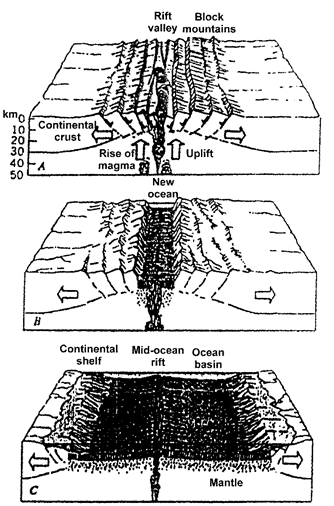
Extent and Relief: Mid Atlantic ridge is the most striking relief feature of the Atlantic ocean, traversing the ocean from Iceland in north to Bouvet island in the south. The general course of the ridge, extending for 14450 km, is parallel to the coastline of bordering continents and assumes an S shape, throwing off many branching ridges towards the coast. The Northern Atlantic ridge is known as Dolphin Rise and the southern part is named as Challenger Rise.
The Atlantic ridge rises near Iceland from where it turns south and south-west. Between Iceland and Scotland, this ridge is known as the Wyvile-Thompson and forms the boundary between Atlantic and the Arctic Oceans. The ridge becomes quite extensive to the south of Greenland and Iceland and is called Telegraphic Plateau. To the west of Telegraphic plateau near 400 N the Azores Rise bifurcates from the central ridge. Again just at the equator the Sierra Leone Rise bifurcates towards the north-east coast of Africa. After 12°N the central ridge turns sharply eastward following the bulge of Africa and moves towards south-east.
At 10°S, the Guinea Rise, formed by 3000 metre contour and less deep is thrown off in north east direction towards the Guinea Coast. However, the most important ridges in the south are those which bifurcates near 40°S where the Mid- Atlantic ridge has the maximum breadth. Walvis ridge between 2000-3000 metre deep is bifurcated from here towards north-east and merges into the African continental shelf. To the west, Rio-Grande Rise is between 3000 and 4000 metres deep and moves north-west towards the coast of South America up to 30°S. At the end of this there is hill like clustering of contours, exhibiting the submarine plateau connected with the rise, known as Bromley plateau. After 40°S the central ridge moves towards south east and forms Meteor Bank and Cape Swell near about 45°S. It proceeds towards the Cape of Good Hope, south of which it is known as the Atlantic – Antarctica ridge.
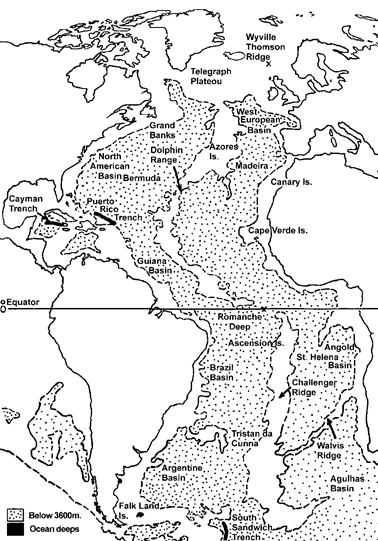
The ridge, though under the sea level has many peaks thrust out above the surface of the ocean in the from of islands. The highest peak of the ridges is Pico Island of Azores. Cape Verde Island in N. Atlantic and Ascencion, Tristan de Kunha, St. Helena, Gaugh and Bouvet Islands in S. Atlantic are important islands on the ridge.
Besides the islands, the Mid-Atlantic ridge has several well-marked fracture zones like Gibbs, Atlantis, Romanche fracture zones etc. These are actually the sites of transform faults formed by differential stretching since the plates are moving along a pole of rotation with minimum velocity at poles increasing equator-ward.
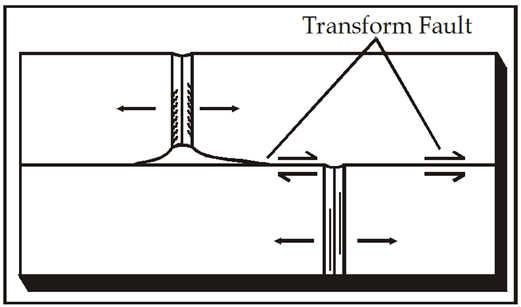
In case you still have your doubts, contact us on 9811333901.
For UPSC Prelims Resources, Click here
For Daily Updates and Study Material:
Join our Telegram Channel – Edukemy for IAS
- 1. Learn through Videos – here
- 2. Be Exam Ready by Practicing Daily MCQs – here
- 3. Daily Newsletter – Get all your Current Affairs Covered – here
- 4. Mains Answer Writing Practice – here

